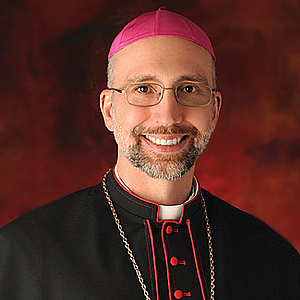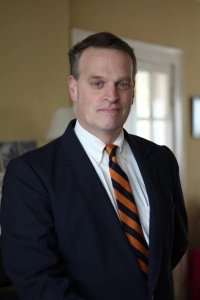I have no idea how his pastoral directive was received, but a belated bravo to Bishop John F. Doerfler of the Diocese of Marquette! Although given on January 26, 2016, I had only become aware of his pastoral directive on sacred music today.

Bishop Doerfler’s letter is bold and stunning.
And as the Director of Music at my parish I think his pastoral instruction represents the only effective method for ensuring that ordinary Catholics will receive the benefit of the Church’s teaching on sacred music. (e.g. the teachings contained in Sacrosanctum Concilium and Tra Le Solecitudini)
Here, in summary, are the five directives from Bishop Doerfler’s instruction Sing to the Lord, All the Earth:
1. All parishes and schools will learn to chant the Ordinary parts of the Mass in English that are found in the Roman Missal, and they will be sung by the congregation some of the time throughout the year.
2. All parishes and schools will learn to chant the KYRIE, SANCTUS and AGNUS DEI from the Missa lubilate Deo, and they will be sung by the congregation some of the time throughout the year.
3. All parishes and schools will learn to chant the Communion Antiphon in English to a very simple tone that everyone can sing, and the Communion Antiphon will be sung at every Sunday Mass….
4. A Diocesan Hymnal will be used to ensure the musical quality and doctrinal integrity of the Sacred Music….
5. The Diocesan Director of Sacred Music will provide annual, regional workshops for parish musicians to assist them in the implementation of these directives. He will also assist music teachers in Catholic schools to implement Sacred Music in the school curriculum and at school Masses…
How else can the ordinary parish expect to foster a return to authentic sacred music?
Before you answer this, consider that the vast majority of Catholics, through no fault of their own, have a deeply ingrained musical custom that has acclimated their ears and musical affections to a type of “religious music” that is significantly other than, say, Gregorian chant.
As the fifth century BC Greek poet Pindar asserted,
Custom, the king of all, of mortals and immortals, leads … by its very powerful hand.
At best, lacking the kind of Diocesan leadership that Bishop Doerfler exemplifies, a maverick pastor might attempt to implement a return to authentic sacred music on his own initiative. But for a pastor to do so is most certainly to ask for trouble. Sure, one does hear anecdotes from time to time about how this or that parish successfully changed its music program to one that resembles actual church teaching on sacred music. But more often than not, the individual parish that implements a sacred music program that includes an emphasis on Gregorian chant, for example, is bound to be viewed by most parishioners as something of an oddity.
“Oh, Father X is sort of a throw-back” or “Father is traditional and likes old stuff.”

Or perhaps the music will be attributed to the quirky tastes of the music director.
“Our Director of Music likes gregorian chant, but I do wish that he could choose some happier more upbeat music.”

And when Father X is transferred, Father Y will either continue to implement the sacred music program already in place, or, what is more likely, he will simply begin to implement a program that is more in tune with the customs and affections of his congregation.
It is improbable that individual pastors or music directors can succeed singlehandedly in implementing a sacred music program in their parishes.

Without a mandate from the diocese any such program will be seen as emanating from personal taste or idiosyncratic preferences of the pastor or music director.
True, perhaps theoretically, through a very careful and cunning long-term plan, coupled with a strategic parish music education program, a pastor or music director might gradually acclimate parishioner’s ears, hearts and affections to Renaissance polyphony and chant, but realistically, the chances of success are slim at best. Individual efforts simply lack authoritative force.
As I spend another weekend in the choir loft, I am not going to give up trying to make our own parish music program prayerful and noble. But without a mandate from above, I will not be singing the Kyrie, Gloria, Sanctus or Agnus Dei.

In the mean time, I will pray that Bishop Doerfler’s pastoral instruction will meet with great success. And I will pray that the successful return to Sacred Music in the Diocese of Marquette will foster and inspire many other bishops to implement similar directives in their own dioceses.





In relation to teaching Catholic music, particularly Gregorian Chant, a viewing of how music is taught in one Estonian school (K-12) is time well spent. The video starts with things all childrens’ music directors need to know. What is striking is what they choose to teach music to young children, namely, Gregorian chant and its notation. They combine Gregorian Chant and notation with the Kodály method with great success Please see: https://youtu.be/6QQJm3dTcOo
It is 44 minutes well spent.
Thanks very much for this link. I can see that many readers have clicked on it and have hoefully been inspired!
I think a lot of good will come from these efforts. That said, new music (both songs and styles) has much to contribute to the liturgy. Recovery of our beautiful traditions hopefully wil not come at the expense of new expressions. Food for thought: a defense of modern worship music in the liturgy http://www.theholyruckus.com/blog/2016/11/3/zncbezwvf330yx3sg11sik24cui1b1
I agree that “new expressions” are to be fostered and welcomed. I particularly am fond of the Responsorial Psalm settings of Dr. Sam Schmitt which may be found at http://noelchabanel.org/psalms/A_ord_07/ among other places
We can attempt to make the case that we really want to do is take Vatican II seriously. To those who are hostile to the sung prayer that’s proper to the Roman rite, we can gently ask, “How can we say that we’re all for Vatican II, when in our liturgies we refuse to give Gregorian chant *any* place at all?”
In such discussions, I’ve always wanted to bring out the Big Red Book that the priest uses at Mass and turn to the General Instruction of the Roman Missal, no. 41:
“The main place should be given, all things being equal, to Gregorian chant, as being proper to the Roman Liturgy. Other kinds of sacred music, in particular polyphony, are in no way excluded, provided that they correspond to the spirit of the liturgical action and that they foster the participation of all the faithful.[50]
“Since the faithful from different countries come together ever more frequently, it is desirable that they know how to sing together at least some parts of the Ordinary of the Mass in Latin, especially the Profession of Faith and the Lord’s Prayer, according to the simpler settings.[51]”
Footnotes:
[50] Cf. Second Ecumenical Council of the Vatican, Constitution on the Sacred Liturgy, Sacrosanctum Concilium, no. 116; cf. also no. 30.
[51] Cf. Second Ecumenical Council of the Vatican, Constitution on the Sacred Liturgy, Sacrosanctum Concilium, no. 54; Sacred Congregation of Rites, Instruction, Inter Oecumenici, September 26, 1964, no. 59: Acta Apostolicae Sedis 56 (1964), p. 891; Instruction, Musicam sacram, March 5, 1967, no. 47: Acta Apostolicae Sedis 59 (1967), p. 314.
Source:
http://www.usccb.org/prayer-and-worship/the-mass/general-instruction-of-the-roman-missal/girm-chapter-2.cfm
How has it been going in the Diocese of Marquette since the Bishop very gently requested these changes? Living in the adjacent Diocese of Superior, I for one am green with envy of those fortunate Catholics in Marquette. Vivat! Vivat Pastor Bonus!
I don’t know how it has been going. I would love to hear about it from someone in the diocese!
The other good news for those fortunates in Marquette is that their Bishop, having made this shocking declaration, has won for himself the assurance of never being “promoted” to another Diocese, so the Marquetsters will enjoy many years of happy stability under his reign. Good for him.
Thanks for your wonderful post. I heard about this back when it happened but it’s nice to know that it is still having an impact in the Diocese of Marquette and will for years to come.
I have more recently been attending liturgy in an Eastern Catholic church. The biggest difference is that … the people sing! They sing because it is the only option they have to participate in the liturgy! Can you imagine the difference, individually and communally, what it would be like in a Roman Catholic church if everyone sang! Yes, you’d feel like you were actually a participant in the Mass.
I hope this directive achieves that humble goal and changes the hearts of those in attendance at Masses in Marquette.
I, too, have attended many Eastern liturgies and can appreciate your comment. Nonetheless, I have witnessed something similar (full and active participation of the faithful) at a recent Pontifical High Mass celebrated by Cardinal Arinze at Sacred Heart fo Jesus Parish – my parish – in South Euclid Ohio 🙂
Pingback: VVEDNESDAY CATHOLICA EDITION | Big Pulpit
I was a member of Sacred Heart in Redlands, CA in the 1980s and at that time the Chant was sung prior to the Mass and during Confession but not during Mass. Living in Denver, I miss Sacred Heart.
“It is improbable that individual pastors or music directors can succeed singlehandedly in implementing a sacred music program in their parishes.” Well, if you make your parish a “destination parish” such success is INDEED possible–and people will travel for hours every Sunday to attend. This is the case with the 9:30 AM Sunday Solemn High Mass at St. Mary’s, Norwalk, Connecticut–which is a Solemn High even during every Sunday of summer: https://youtu.be/P26jjOCv4PY